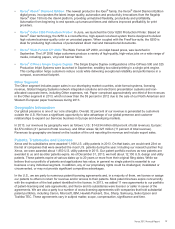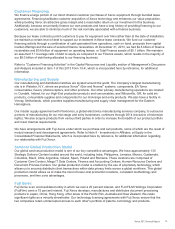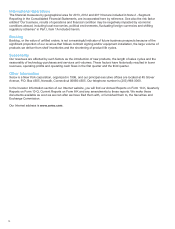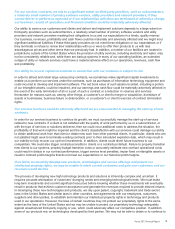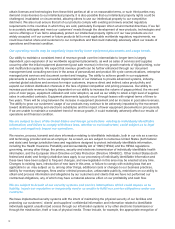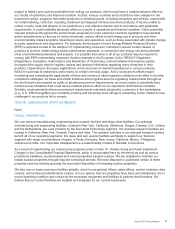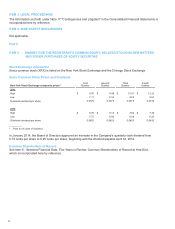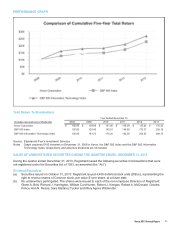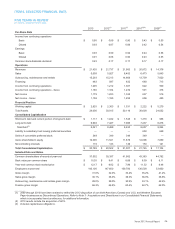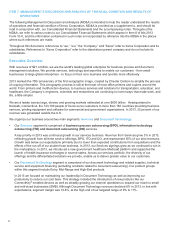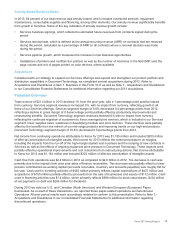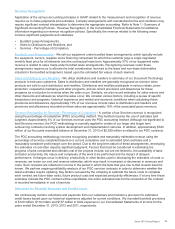Xerox 2013 Annual Report Download - page 37
Download and view the complete annual report
Please find page 37 of the 2013 Xerox annual report below. You can navigate through the pages in the report by either clicking on the pages listed below, or by using the keyword search tool below to find specific information within the annual report.information. Despite such efforts, we are subject to breach of security systems which may result in unauthorized
access to our facilities and/or the information we are trying to protect. Because the techniques used to obtain
unauthorized access change frequently and often are not recognized until launched against a target, we may be
unable to anticipate these techniques or implement preventative measures. If unauthorized parties gain physical
access to one of our facilities or electronic access to our information systems or such information is misdirected, lost
or stolen during transmission or transport, any theft or misuse of such information could result in, among other
things, unfavorable publicity, governmental inquiry and oversight, difficulty in marketing our services, allegations by
our customers and clients that we have not performed our contractual obligations, litigation by affected parties and
possible financial obligations for damages related to the theft or misuse of such information, any of which could
have a material adverse effect on our profitability and cash flow. We also maintain various systems and data centers
for our customers. Often these systems and data centers must be maintained worldwide and on a 24/7 basis.
Although we endeavor to ensure that there is adequate back-up and maintenance of these systems and centers, we
could experience service interruptions that could result in curtailed operations and loss of customers, which would
reduce our revenue and profits in addition to impairing our reputation.
Our ability to fund our customer financing activities at economically competitive levels depends on our
ability to borrow and the cost of borrowing in the credit markets.
The long-term viability and profitability of our customer financing activities is dependent, in part, on our ability to
borrow and the cost of borrowing in the credit markets. This ability and cost, in turn, is dependent on our credit
ratings and is subject to credit market volatility. We primarily fund our customer financing activity through a
combination of cash generated from operations, cash on hand, capital market offerings, sales and securitizations of
finance receivables and commercial paper borrowings. Our ability to continue to offer customer financing and be
successful in the placement of equipment with customers is largely dependent on our ability to obtain funding at a
reasonable cost. If we are unable to continue to offer customer financing, it could materially adversely affect our
results of operations and financial condition.
Our significant debt could adversely affect our financial health and pose challenges for conducting our
business.
We have and will continue to have a significant amount of debt and other obligations, primarily to support our
customer financing activities. Our substantial debt and other obligations could have important consequences. For
example, it could (i) increase our vulnerability to general adverse economic and industry conditions; (ii) limit our
ability to obtain additional financing for future working capital, capital expenditures, acquisitions and other general
corporate requirements; (iii) increase our vulnerability to interest rate fluctuations because a portion of our debt has
variable interest rates; (iv) require us to dedicate a substantial portion of our cash flows from operations to service
debt and other obligations thereby reducing the availability of our cash flows from operations for other purposes;
(v) limit our flexibility in planning for, or reacting to, changes in our businesses and the industries in which we
operate; (vi) place us at a competitive disadvantage compared to our competitors that have less debt; and
(vii) become due and payable upon a change in control. If new debt is added to our current debt levels, these
related risks could increase.
We need to maintain adequate liquidity in order to meet our operating cash flow requirements, repay
maturing debt and meet other financial obligations, such as payment of dividends to the extent declared by
our Board of Directors. If we fail to comply with the covenants contained in our various borrowing
agreements, it may adversely affect our liquidity, results of operations and financial condition.
Our liquidity is a function of our ability to successfully generate cash flows from a combination of efficient operations
and improvement therein, access to capital markets and funding from third parties. We believe our liquidity
(including operating and other cash flows that we expect to generate) will be sufficient to meet operating
requirements as they occur; however, our ability to maintain sufficient liquidity going forward depends on our ability
to generate cash from operations and access to the capital markets and funding from third parties, all of which are
subject to general economic, financial, competitive, legislative, regulatory and other market factors that are beyond
our control.
Xerox 2013 Annual Report 20




